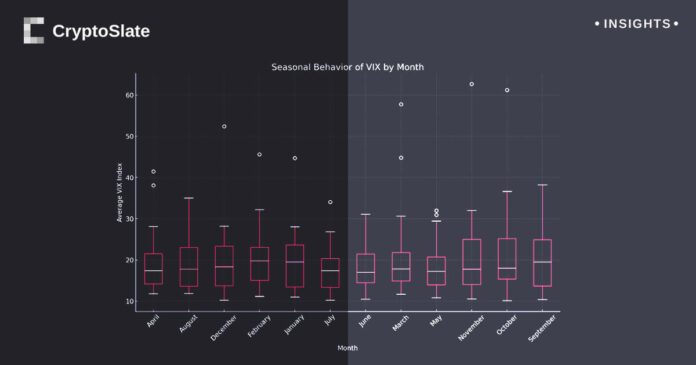Quick Take
An analysis of the CBOE Volatility Index (VIX), a critical market indicator often used to measure the market’s expectation of future volatility, reveals intriguing patterns. The evaluation of average daily change in the VIX from 1990 to 2023 indicates a propensity for the index to dip markedly on Fridays, with Tuesdays trailing. This trend substantiates the existing theory of VIX compression on Fridays, adding empirical validation to this common market belief.
On a broader scale, a boxplot distribution of the average VIX index across each month of these years unveils seasonal tendencies. October and November, characterized by wider VIX distributions, are indicative of heightened variability. This observation reinforces the perception of these months being more prone to volatility. On the flip side, months such as May and June exhibit lower VIX averages, signaling periods of reduced volatility.
Interestingly, certain months like October spotlight outliers, suggesting instances when the VIX notably deviated from its typical range. This signifies years when volatility in the equities market reached exceptional highs or dipped to unusual lows.
These insights into the weekly and seasonal VIX patterns provide a data-driven lens to understand the rhythm of the equities market, a crucial aspect of strategic financial planning and decision-making.

The post Surges in market volatility pinned to autumn months appeared first on CryptoSlate.
Credit: Source link






















 Bitcoin
Bitcoin  Ethereum
Ethereum  Tether
Tether  Solana
Solana  USDC
USDC  XRP
XRP  Lido Staked Ether
Lido Staked Ether  Dogecoin
Dogecoin  Toncoin
Toncoin  Cardano
Cardano  Shiba Inu
Shiba Inu  Avalanche
Avalanche  TRON
TRON  Wrapped Bitcoin
Wrapped Bitcoin  Polkadot
Polkadot  Bitcoin Cash
Bitcoin Cash  Chainlink
Chainlink  NEAR Protocol
NEAR Protocol  Polygon
Polygon  Litecoin
Litecoin  Internet Computer
Internet Computer  Uniswap
Uniswap  Fetch.ai
Fetch.ai  Dai
Dai  LEO Token
LEO Token  Hedera
Hedera  Ethereum Classic
Ethereum Classic  Aptos
Aptos  First Digital USD
First Digital USD  Pepe
Pepe  Render
Render  Cronos
Cronos  Cosmos Hub
Cosmos Hub  Stacks
Stacks  Mantle
Mantle  dogwifhat
dogwifhat  Filecoin
Filecoin  Immutable
Immutable  Stellar
Stellar  Wrapped eETH
Wrapped eETH  Renzo Restaked ETH
Renzo Restaked ETH  XT.com
XT.com  OKB
OKB  Optimism
Optimism  Bittensor
Bittensor  Arbitrum
Arbitrum  Maker
Maker  The Graph
The Graph 
